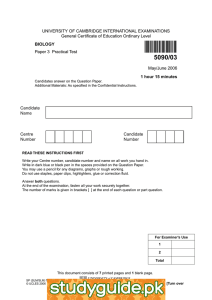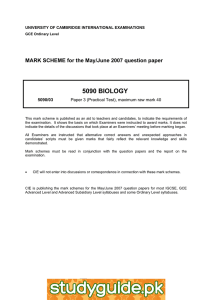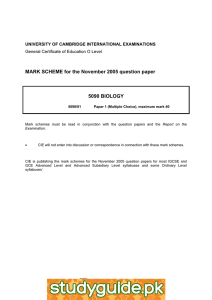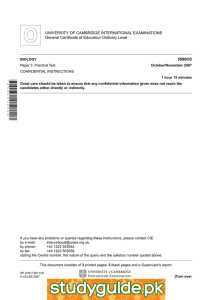UNIVERSITY OF CAMBRIDGE INTERNATIONAL EXAMINATIONS General Certificate of Education Ordinary Level 5090/01
advertisement
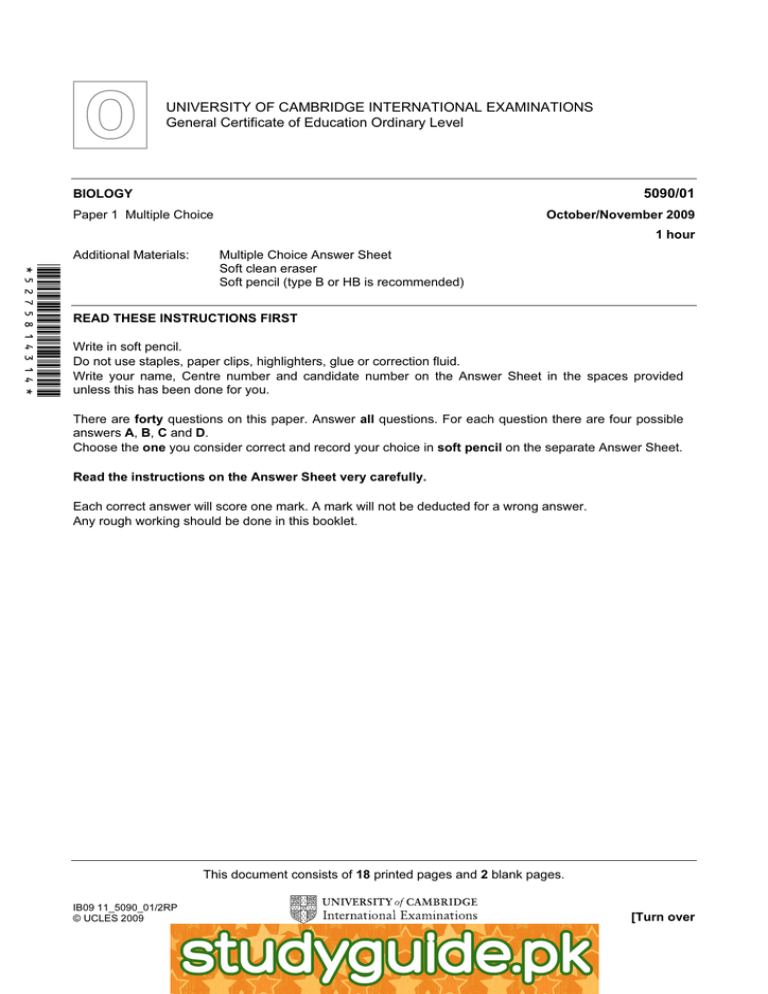
UNIVERSITY OF CAMBRIDGE INTERNATIONAL EXAMINATIONS General Certificate of Education Ordinary Level 5090/01 BIOLOGY Paper 1 Multiple Choice October/November 2009 1 hour Additional Materials: *5275814314* Multiple Choice Answer Sheet Soft clean eraser Soft pencil (type B or HB is recommended) READ THESE INSTRUCTIONS FIRST Write in soft pencil. Do not use staples, paper clips, highlighters, glue or correction fluid. Write your name, Centre number and candidate number on the Answer Sheet in the spaces provided unless this has been done for you. There are forty questions on this paper. Answer all questions. For each question there are four possible answers A, B, C and D. Choose the one you consider correct and record your choice in soft pencil on the separate Answer Sheet. Read the instructions on the Answer Sheet very carefully. Each correct answer will score one mark. A mark will not be deducted for a wrong answer. Any rough working should be done in this booklet. This document consists of 18 printed pages and 2 blank pages. IB09 11_5090_01/2RP © UCLES 2009 [Turn over www.xtremepapers.net 2 1 2 Which processes can take place in a root hair cell when oxygen is not available? A active transport only B diffusion only C active transport and osmosis only D diffusion and osmosis only The diagram represents a cell as seen under the electron microscope. What type of cell is this? type of cell reason A animal cell outer layer is the cell membrane B bacterium no chromosomes are visible C plant cell cytoplasm is visible D plant cell cell wall is visible © UCLES 2009 5090/01/O/N/09 www.xtremepapers.net 3 3 The table shows the concentrations of some mineral ions in the root hair of a plant and in the soil around it. mineral ion concentration in the root hair (arbitrary units) concentration in the soil (arbitrary units) magnesium 75 15 nitrate 126 47 How are these mineral ions absorbed from the soil by the plant? 4 magnesium nitrate A active transport active transport B active transport diffusion C diffusion active transport D diffusion diffusion Protease breaks down proteins into amino acids. In the ‘lock and key’ hypothesis, what is the lock and what is the key? 5 lock key A amino acid protease B protease amino acid C protease protein D protein protease The diagram shows some chemical reactions that occur in plants. 1 carbon dioxide and water 2 sugars 3 amino acids proteins Which stage or stages depend on the use of nitrate ions as a raw material? A 1 only B 2 only C 1 and 3 only D 2 and 3 only © UCLES 2009 5090/01/O/N/09 www.xtremepapers.net [Turn over 4 6 The diagram shows a transverse section of a leaf. 1 2 3 4 5 Which cells absorb carbon dioxide? A 7 B 1, 2 and 3 C 2, 3 and 4 D 2, 4 and 5 1, 3 and 5 Temperature, light intensity and carbon dioxide concentration are three limiting factors in photosynthesis. In an experiment, each factor is increased in turn. The graph shows the results. rate of photosynthesis 3 2 1 0 0 time Which numbered points represent when each factor was increased? carbon dioxide concentration light intensity temperature A 1 2 3 B 2 3 1 C 3 1 2 D 3 2 1 © UCLES 2009 5090/01/O/N/09 www.xtremepapers.net 5 8 9 Which row in the table correctly identifies the deficiency diseases caused by lack of vitamin C, calcium and iron? lack of vitamin C lack of calcium lack of iron A anaemia rickets scurvy B brittle bones anaemia rickets C rickets scurvy brittle bones D scurvy brittle bones anaemia Four bags made of partially permeable membrane are placed in tubes of water as shown in the diagram. tube 1 bag made of partially permable membrane tube 2 starch solution tube 3 reducing sugar solution tube 4 starch solution and saliva water saliva water After 20 minutes at 35 °C a sample of the water around the bag in each tube is boiled with Benedict’s solution. What are the expected results? tube 1 tube 2 tube 3 tube 4 A blue orange blue orange B blue orange orange blue C orange blue orange blue D orange orange blue orange © UCLES 2009 5090/01/O/N/09 www.xtremepapers.net [Turn over 6 10 Four foods were analysed for protein, fat and carbohydrate. Which food contains the most energy in a 100 g portion? protein % fat % carbohydrate % A 20 7 1 B 10 9 20 C 4 5 6 D 0.5 0.5 5 11 During translocation in plants, which substance is moved and in which direction? substance from to A sucrose anthers stigmas B sucrose leaves roots C water roots leaves D water soil root hairs 12 Which substances are transported in the phloem and which in the xylem? phloem xylem A nitrate ions sugar B starch nitrate ions C sugar water D water starch 13 Blood enters the left atrium (left auricle) of the heart through A the aorta. B the bicuspid valve. C the posterior vena cava. D the pulmonary vein. © UCLES 2009 5090/01/O/N/09 www.xtremepapers.net 7 14 The diagram shows a plan of part of the circulatory system. lungs X Y liver gut kidney Which vessel must the blood pass through in flowing from X to Y? A hepatic artery B hepatic portal vein C pulmonary artery D renal vein © UCLES 2009 5090/01/O/N/09 www.xtremepapers.net [Turn over 8 15 The graph shows pressure changes in the left side of the heart, during a single heart beat. At which point do the semi-lunar valves open? A B C D 16 key 12 pressure / kPa pressure in atrium pressure in ventricle pressure in aorta 8 4 0 0.0 0.2 0.4 0.6 time / s 16 The diagram illustrates changes in air pressure taking place inside the lungs during a complete cycle of breathing. Which position on the graph corresponds to the point at which the ribs are beginning to be raised? B C pressure in lungs A D expiration © UCLES 2009 time inspiration 5090/01/O/N/09 www.xtremepapers.net 9 17 The diagram shows part of the human gas exchange system. W X Y Z What are W, X, Y and Z? bronchus bronchiole larynx trachea A W X Z Y B X Z Y W C Y W X Z D Z Y W X 18 When breathing out, which changes occur in the volume of the thorax, the rib cage and the diaphragm? volume of thorax rib cage diaphragm A decreases lowered rises B decreases raised pulled down C increases lowered rises D increases raised pulled down © UCLES 2009 5090/01/O/N/09 www.xtremepapers.net [Turn over 10 19 The diagram shows an arm movement. Which joint is working to allow this movement? A a ball and socket joint at the elbow B a ball and socket joint at the shoulder C a hinge joint at the elbow D a hinge joint at the shoulder 20 The diagram represents part of a kidney machine. dialysis fluid out blood in dialysis fluid in blood out Which substance must be at the same concentration in the dialysis fluid and in the blood? A glucose B salt C urea D water © UCLES 2009 5090/01/O/N/09 www.xtremepapers.net 11 21 When a person moves from a cold room into a hot room, the following responses occur. 1 The brain co-ordinates the response. 2 The skin begins to secrete sweat. 3 Sweat evaporates from the skin surface. 4 Temperature receptors are stimulated in the skin. What is the correct sequence of events? A 3→4→1→2 B 2→3→4→1 C 4→1→2→3 D 1→4→2→3 22 The diagram is a section through the human head showing the brain and associated structures. Y X Z w Where are the cerebellum and the pituitary gland? cerebellum pituitary gland A W Z B X Y C Y W D Z X © UCLES 2009 5090/01/O/N/09 www.xtremepapers.net [Turn over 12 23 A person is sitting in a dark room. What happens in the eye when a light is switched on? circular muscle of iris size of pupil A contracts decreases B contracts increases C relaxes decreases D relaxes increases 24 Which disease can be caused by excessive consumption of alcohol? A bronchitis B cirrhosis C emphysema D lung cancer 25 A patient with a sore throat went to the doctor. The doctor examined the patient and then prescribed an antibiotic as treatment. What was the cause of the sore throat? A bacteria B tobacco smoke C viruses D yeasts 26 Two species of bacteria work together and make yoghurt. What do they produce? ethanol lactic acid protease A B C D © UCLES 2009 5090/01/O/N/09 www.xtremepapers.net 13 27 The graph shows the rate of growth of the fungus Penicillium and the amount of penicillin produced when grown in a fermenter. rate of growth / arbitary units of Penicillium 10 600 9 540 8 480 7 420 6 360 Penicillium 5 300 penicillin 4 240 3 180 2 120 1 60 0 0 12 24 36 48 60 72 84 96 108 units of penicillin produced 0 120 time (hours) After how long should the penicillin be removed from the fermenter to obtain the most yield in the shortest time? A 54 hours B 80 hours C 96 hours D 120 hours 28 Which situation does not involve the cycling of the factor named? A carbon dioxide between plants, animals and the atmosphere B energy along a food web of producers and consumers C nitrogen between plants, animals, bacteria and the atmosphere D water in an ecosystem © UCLES 2009 5090/01/O/N/09 www.xtremepapers.net [Turn over 14 29 The diagram below shows part of a pond food web. microscopic animal microscopic algae How many primary consumers are shown in this food web? A B 1 C 2 D 3 4 30 The diagram shows part of the nitrogen cycle. Which stage depends on nitrifying bacteria? plant protein animal protein A nitrogen dead matter B D C nitrate ammonia 31 What are the roles of the mosquito and the malarial parasite in the spread of malaria? mosquito malarial parasite A host vector B pathogen host C pathogen vector D vector pathogen © UCLES 2009 5090/01/O/N/09 www.xtremepapers.net 15 32 A farmer sprays some fields with nitrogen fertilizers. Soon afterwards, the fertilizer is washed off by heavy rain into a nearby lake. Then, a few weeks later, most of the organisms in the water die. The list includes the main stages of this process. P Light is blocked from deeper water plants. Q Plants cannot photosynthesise and die. R Algae multiply rapidly on the lake surface. S Oxygen levels fall and aerobic organisms die. T Aerobic bacteria feed on dead plants. In what order do these stages occur? A P→R→T→Q→S B Q→S→P→R→T C R→P→Q→T→S D S→T→P→Q→R 33 Male and female sea urchins release their sperm and eggs into the water where fertilisation takes place. How can their reproduction be described? A asexual reproduction which results in genetically dissimilar offspring B asexual reproduction which results in genetically identical offspring C sexual reproduction which results in genetically dissimilar offspring D sexual reproduction which results in genetically identical offspring 34 A plant P is pollinated. A seed from this plant develops into plant Q. The cells of plant Q contain 14 chromosomes. How many of these chromosomes are identical to chromosomes from plant P? if P was self pollinated if P was cross pollinated A 7 7 B 7 14 C 14 7 D 14 14 © UCLES 2009 5090/01/O/N/09 www.xtremepapers.net [Turn over 16 35 What is the sequence of structures through which a mammalian sperm passes after leaving the penis and before fusing with an ovum? A ureter → uterus→ vagina B vagina → fallopian tube → ovary C vagina → urethra → fallopian tube D vagina → uterus → fallopian tube 36 The diagram shows a fetus in the uterus. Y X Which substances will be at a higher concentration at Y than at X? A carbon dioxide and glucose B carbon dioxide and urea C glucose and oxygen D oxygen and urea © UCLES 2009 5090/01/O/N/09 www.xtremepapers.net 17 37 The diagram shows two distinct forms of beetle. The difference between them is controlled by a single gene. The allele for the black form is dominant to the allele for red. red form with black spots black form with red spots What kind of variation is shown by the beetle and why? A continuous variation because it is controlled by genes B continuous variation because there are two forms C discontinuous variation because it is controlled by genes D discontinuous variation because the two forms are distinct 38 A pregnant woman is told by a genetic counsellor that her baby has equal chances of being blood group A or blood group AB. What are possible genotypes of the woman and her husband? A AA and BO B AB and BO C AO and BB D AB and AO 39 Which statement about the genotypes of organisms is correct? A Dominant alleles are only found in homozygotes. B One recessive allele always causes a recessive phenotype. C Recessive phenotypes must be homozygous. D The dominant phenotype must be heterozygous. © UCLES 2009 5090/01/O/N/09 www.xtremepapers.net [Turn over 18 40 The diagram shows the inheritance of a recessive characteristic that is controlled by a single pair of alleles, T and t. P Q key normal male normal female affected male affected female T represents the dominant allele and t represents the recessive allele. What are the most likely genotypes of individuals P and Q? P Q A Tt Tt B Tt TT C TT Tt D TT TT © UCLES 2009 5090/01/O/N/09 www.xtremepapers.net 19 BLANK PAGE 5090/01/O/N/09 www.xtremepapers.net 20 BLANK PAGE Permission to reproduce items where third-party owned material protected by copyright is included has been sought and cleared where possible. Every reasonable effort has been made by the publisher (UCLES) to trace copyright holders, but if any items requiring clearance have unwittingly been included, the publisher will be pleased to make amends at the earliest possible opportunity. University of Cambridge International Examinations is part of the Cambridge Assessment Group. Cambridge Assessment is the brand name of University of Cambridge Local Examinations Syndicate (UCLES), which is itself a department of the University of Cambridge. 5090/01/O/N/09 www.xtremepapers.net


